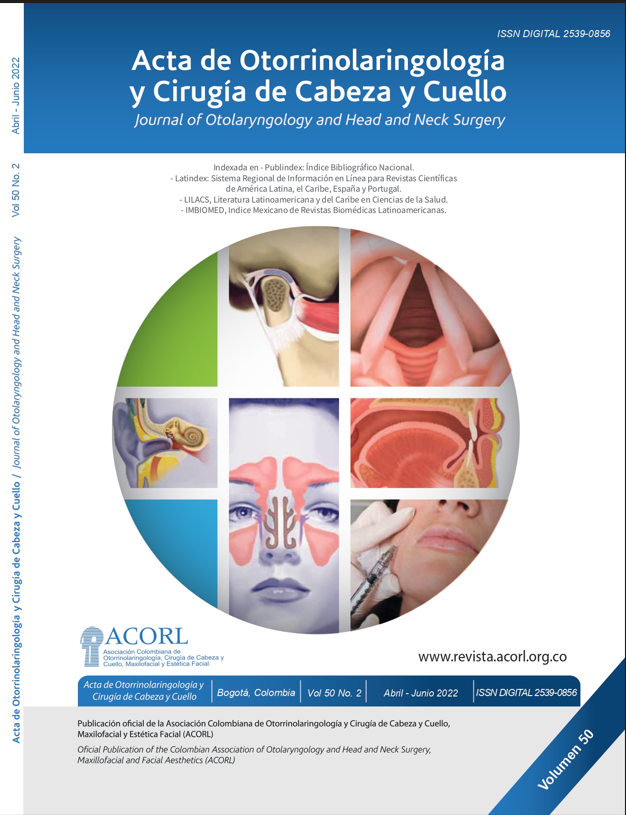Concordance of the TI-RADS classification and the Bethesda System to detect malignancy in patients with thyroid nodule
Main Article Content
Abstract
Introduction: Evaluate the concordance of the TI-RADS classification and the
Bethesda system to detect malignancy in patients with a thyroid nodule. Material
and Methods: Through an observational, retrospective and cross-sectional study
in 90 patients with a diagnosis of thyroid nodule, to which neck ultrasound was
performed, definitive histopathological study and the TI-RADS (Thyroid Imaging
Reporting and Data System) and Bethesda scales were applied during their approach
from July 2018 to November 2020. Results: obtaining as a result, a predominance
of the female sex, a sensitivity of 43.6% and specificity of 94.2% in classification of
TI-RADS. Regarding the Bethesda classification, we obtained a sensitivity of 94.5%
and a specificity of 51.4%. With a low agreement as a result between the two tests.
Discussion: according to the results obtained in our study, we could verify that patients
with thyroid nodules benefit from an appropriate approach that includes a neck
Doppler USG, performed by a trained professional, in addition to the realization of
a Fine Needle Aspiration Biopsy (FNA) in the cases in which they are well indicated.
The concordance test was low; therefore, we consider it necessary to use both
diagnostic tests within clinical practice. Conclusion: the correct use of the TI-RADS
classification to identify the characteristics of a thyroid nodule allows reliable differentiation
to patients to undergo a FNA of those who do not require it. The Bethesda
system can support decision making or change therapeutic behavior, especially in
patients with high suspicion of malignancy.
Downloads
Article Details

This work is licensed under a Creative Commons Attribution-ShareAlike 4.0 International License.
Este artículo es publicado por la Revista Acta de Otorrinolaringología & Cirugía de Cabeza y Cuello.
Este es un artículo de acceso abierto, distribuido bajo los términos de la LicenciaCreativeCommons Atribución-CompartirIgual 4.0 Internacional.( http://creativecommons.org/licenses/by-sa/4.0/), que permite el uso no comercial, distribución y reproducción en cualquier medio, siempre que la obra original sea debidamente citada.
eISSN: 2539-0856
ISSN: 0120-8411
References
Grani G, Lamartina L, Ascoli V, Bosco D, Biffoni M, Giacomelli L, et al. Reducing the Number of Unnecessary Thyroid Biopsies While Improving Diagnostic Accuracy: Toward the “Right”TIRADS. J Clin Endocrinol Metab. 2019;104(1):95-102. doi: 10.1210/jc.2018-01674
Russ G, Bonnema SJ, Erdogan MF, Durante C, Ngu R,Leenhardt L. European Thyroid Association Guidelines for
Ultrasound Malignancy Risk Stratification of Thyroid Nodules in Adults: The EU-TIRADS. Eur Thyroid J. 2017;6(5):225-
doi: 10.1159/000478927
Vargas-Uricoechea H, Meza-Cabrera I, Herrera-Chaparro J.Concordance between the TIRADS ultrasound criteria and the
BETHESDA cytology criteria on the nontoxic thyroid nodule.Thyroid Res. 2017;10:1. doi: 10.1186/s13044-017-0037-2
Zhuang Y, Li C, Hua Z, Chen K, Lin JL. A novel TIRADS of US classification. Biomed Eng Online. 2018;17(1):82. doi:
1186/s12938-018-0507-3
Skowronska A, Milczarek-Banach J, Wiechno W, Chudzinski W, Zach M, Mazurkiewicz M, et al. Accuracy of the
European Thyroid Imaging Reporting and Data System (EUTIRADS) in the valuation of thyroid nodule malignancy in
reference to the post-surgery histological results. Pol J Radiol.2018;83:e579-e586. doi: 10.5114/pjr.2018.81556
Gao L, Xi X, Jiang Y, Yang X, Wang Y, Zhu S, et al. Comparison among TIRADS (ACR TI-RADS and KWAK- TI-RADS) and
ATA Guidelines in the diagnostic efficiency of thyroid nodules. Endocrine. 2019;64(1):90-96. doi: 10.1007/s12020-
-01843-x
Wu XL, Du JR, Wang H, Jin CX, Sui GQ, Yang DY, et al. Comparison and preliminary discussion of the reasons for the
differences in diagnostic performance and unnecessary FNA biopsies between the ACR TIRADS and 2015 ATA guidelines.
Endocrine. 2019;65(1):121-131. doi: 10.1007/s12020-019-01886-0
Jin ZQ, Yu HZ, Mo CJ, Su RQ. Clinical Study of the Prediction of Malignancy in Thyroid Nodules: Modified
Score versus 2017 American College of Radiology’s Thyroid Imaging Reporting and Data System Ultrasound Lexicon.
Ultrasound Med Biol. 2019;45(7):1627-1637. doi: 10.1016/j.ultrasmedbio.2019.03.014
Trimboli P, Ngu R, Royer B, Giovanella L, Bigorgne C, Simo R, et al. A multicentre validation study for the EU-TIRADS
using histological diagnosis as a gold standard. Clin Endocrinol(Oxf). 2019;91(2):340-347. doi: 10.1111/cen.13997
Singaporewalla RM, Hwee J, Lang TU, Desai V. Clinicopathological Correlation of Thyroid Nodule Ultrasound and
Cytology Using the TIRADS and Bethesda Classifications. World J Surg. 2017;41(7):1807-1811. doi: 10.1007/s00268-
-3919-5
Mistry R, Hillyar C, Nibber A, Sooriyamoorthy T, Kumar N.Ultrasound Classification of Thyroid Nodules: A Systematic
Review. Cureus. 2020;12(3):e7239. doi: 10.7759/cureus.7239

